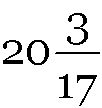Time & Work Worksheet-2
-
A and B can do a piece of work in 72 days; B and C can do it in 120 days; A and C can do it in 90 days. In what time can A alone do it?
(a) 80 days (b) 100 days (c) 120 days (d) 150 days
-
A and B can do a piece of work in 5 days; B and C can do it in 7 days; A and C can do it in 4 days. Who among these will take the least time if put to do it alone?
(a) A (b) B (c) C (d) Data inadequate
-
A can do a piece of work in 4 hours; B and C together can do it in 3 hours, while A and C together can do it in 2 hours. How long will B alone take to do it?
(a) 8 hours (b) 10 hours (c) 12 hours (d) 24 hours
-
A can do a certain work in the same time in which B and C together can do it. If A and B together could do it in 10 days and C alone in 50 days, then B alone could do it in:
(a) 15 days (b) 20 days (c) 25 days (d) 30 days
-
A works twice as fast as B. If B can complete a work in 12 days independently, the number of days in which A and B can together finish the work is:
(a) 4 days (b) 6 days (c) 8 days (d) 18 days
-
A is twice as good a workman as B and together they finish a piece of work in 14 days. The number of days taken by A alone to finish the work is:
(a) 11 (b) 21 (c) 28 (d) 42
-
A is thrice as good a workman as B and therefore is able to finish a job in 60 days less than B. Working together, they can do it in:
(a) 20 days (b)  days (c) 25 days (d) 30 days
days (c) 25 days (d) 30 days
-
A and B can do a job together in 7 days. A is
 times as efficient as B. The same job can be done by A alone in:
times as efficient as B. The same job can be done by A alone in:
(a)  days (b) 11 days (c)
days (b) 11 days (c)  days (d)
days (d)  days
days
-
Sakshi can do a piece of work in 20 days. Tanya is 25% more efficient than Sakshi. The number of days taken by Tanya to do the same piece of work is:
(a) 15 (b) 16 (c) 18 (d) 25
-
A is 30% more efficient than B. How much time will they, working together, take to complete a job which A alone could have done in 23 days?
(a) 11 days (b) 13 days (c)  days (d) None of these
days (d) None of these
-
A does half as much work as B in three-fourth of the time. If together they take 18 days to complete the work, how much time shall B take to do it?
(a) 30 days (b) 35 days (c) 40 days (d) None of these
-
A is 50% as efficient as B. C does half of the work done by A and B together. If C alone does the work in 40 days, then A, B and C together can do the work in:
(a)  days (b) 15 days (c) 20 days (d) 30 days
days (b) 15 days (c) 20 days (d) 30 days
-
Two workers A and B working together completed a job in 5 days. If A worked twice as efficiently as he actually did and B worked
 as efficiently as he actually did, the work would have been completed in 3 days. A alone could complete the work in:
as efficiently as he actually did, the work would have been completed in 3 days. A alone could complete the work in:
(a)  days (b)
days (b)  days (c)
days (c)  days (d) None of these
days (d) None of these
-
A can do a work in 15 days and B in 20 days. If they work on it together for 4 days, then the fraction of the work that is left is:
(a)  (b)
(b)  (c)
(c)  (d)
(d) 
-
A can finish a work in 18 days and B can do the same work in 15 days. B worked for 10 days and left the job. In how many days, A alone can finish the remaining work?
(a) 5 (b)  (c) 6 (d) 8
(c) 6 (d) 8
Answer Key:
(1)-c; (2)-a; (3)-c; (4)-c; (5)-a; (6)-b; (7)-b; (8)-b; (9)-b; (10)-b; (11)-a; (12)-a; (13)-b; (14)-d; (15)-c
 days (c) 25 days (d) 30 days
days (c) 25 days (d) 30 days times as efficient as B. The same job can be done by A alone in:
times as efficient as B. The same job can be done by A alone in: days (b) 11 days (c)
days (b) 11 days (c)  days (d)
days (d)  days
days days (d) None of these
days (d) None of these days (b) 15 days (c) 20 days (d) 30 days
days (b) 15 days (c) 20 days (d) 30 days as efficiently as he actually did, the work would have been completed in 3 days. A alone could complete the work in:
as efficiently as he actually did, the work would have been completed in 3 days. A alone could complete the work in: days (b)
days (b)  days (c)
days (c)  days (d) None of these
days (d) None of these (b)
(b)  (c)
(c)  (d)
(d) 
 (c) 6 (d) 8
(c) 6 (d) 8